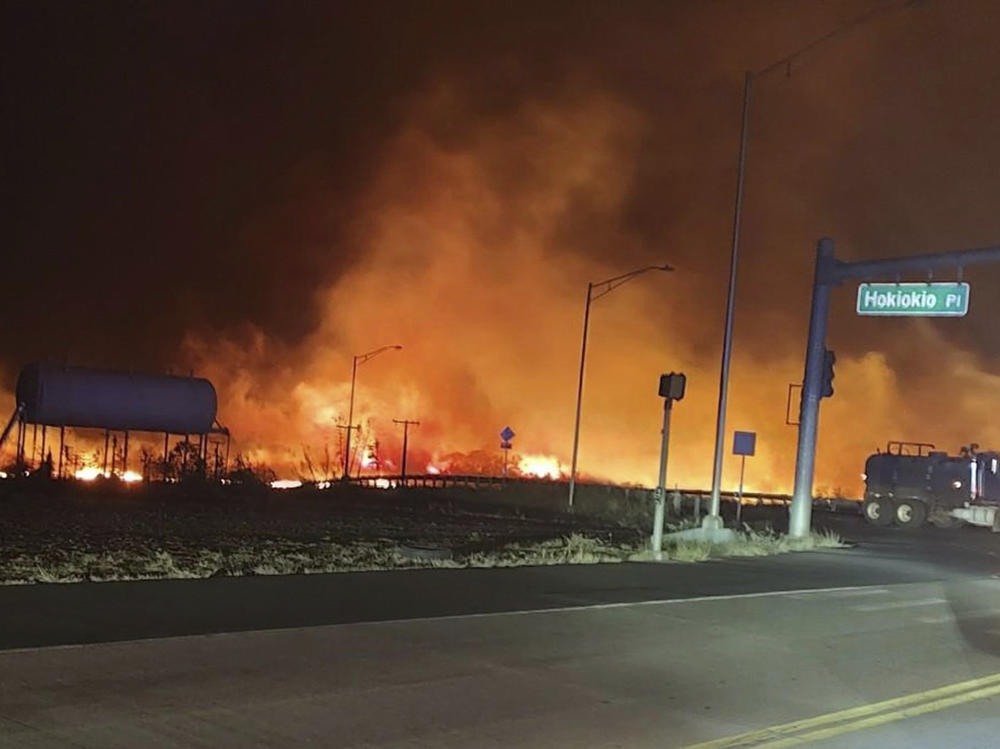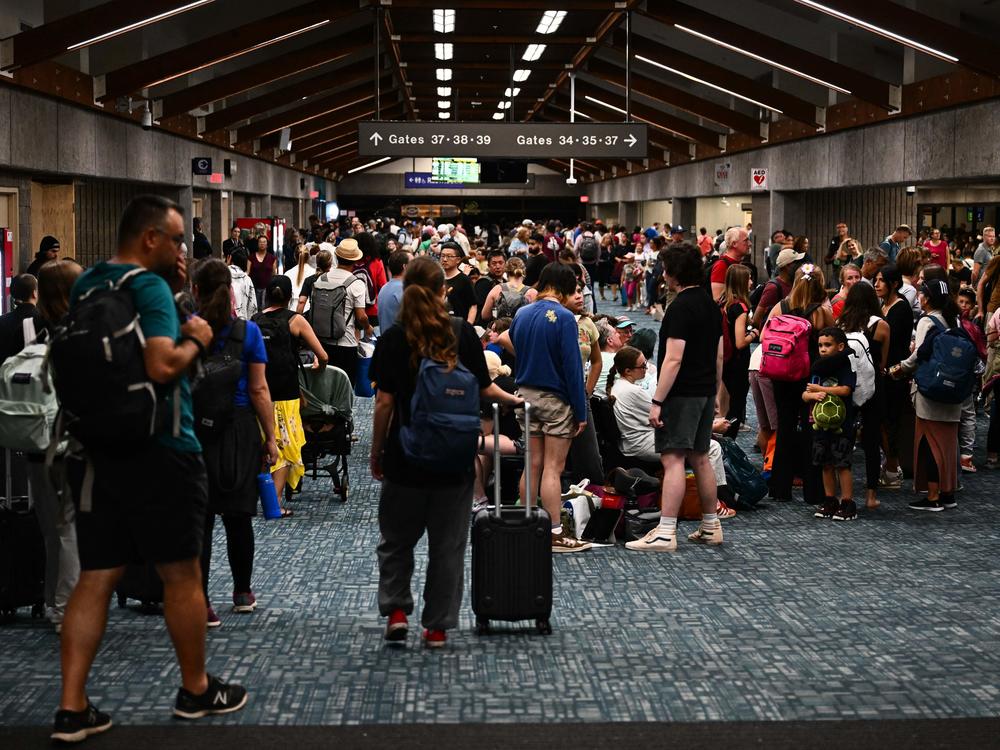Loading...
Section Branding
Header Content
Biden declares a major disaster after hurricane-fueled wildfires kill dozens in Maui
Primary Content
Updated August 10, 2023 at 2:08 PM ET
Federal help is on the way for the Hawaiian island of Maui, where wildfires have killed at least 36 people, torched thousands of acres, destroyed hundreds of structures and sent scores of residents and visitors fleeing.
Officials say it could take years — or longer — to repair the damage.
President Biden approved a federal major disaster declaration on Thursday afternoon, making funding available to people, governments and nonprofits affected by the wildfires.
The White House said he also spoke on the phone with Hawaii Gov. Josh Green and expressed "his deep condolences for the lives lost and vast destruction of land and property."
Hawaii is also getting assistance from the Federal Emergency Management Agency (FEMA) and the National Guard, Lieutenant Gov. Sylvia Luke told Morning Edition. But she cautions that it will take the island, and its people, a long time to recover.
"A lot of individuals will have mental health issues that they're suffering. They have never been in a situation where they just overnight lost the businesses that they invested in," she says. "It's going to take years, sometimes maybe decades, for us to replace some of the infrastructure, including schools and roads."
Officials say some 14,000 residents remain without power as crews work to contain the blazes.
The historic town of Lahaina — a popular tourist destination and economic hub — has been especially hard-hit. Luke got a glimpse of the destroyed homes and businesses firsthand while taking a Coast Guard flight over the area.
"It just looked like the whole town went ... into ashes," she said. "And we're so heartbroken to see this happen before our eyes."
Officials say the wildfires have burned some 11,000 acres and destroyed at least 271 structures. An unknown number of people are being treated for burns and smoke inhalation, either on site or after being medevaced to Oahu, Luke said.
The Coast Guard said it rescued 14 people from the waters off of Lahaina — at least some of whom had jumped into the ocean to escape the flames.
And emergency evacuations forced many people into emergency shelters or off the island altogether.
Some 11,000 visitors left Maui on Wednesday, about 600 stayed overnight at the airport for Thursday morning flights and another 1,500 or so are expected to depart today, Hawaii Public Radio's Bill Dorman told Morning Edition.
Luke said internet and cell phone service are down on parts of the island, making it hard for people to check in with their loved ones or call for help.
And while the Big Island and Maui County have shelters, she says they are crowded with evacuees and have also been forced to close down and reopen in new locations to avoid the fire's path.
Government officials and airlines say they are working to help fly passengers off the island. Hawaii's tourism authorities have asked non-essential travelers to leave and reconsider any upcoming trips.
"In the days and weeks ahead, our collective resources and attention must be focused on the recovery of residents and communities that were forced to evacuate their homes and businesses," reads a notice on its website.
The rare hurricane-wildfire combination
Hurricanes are commonplace this time of year in Hawaii, which is used to heavy rainfall and significant flooding that can follow.
But officials say fierce winds from Hurricane Dora — which is passing far south of the islands — fanned the fires, making for a rare and deadly combination.
"We have never experienced this type of wildfires as a result of a hurricane," Luke said.
Luke said high temperatures on the island created wildfire conditions to begin with, and the Category 4 hurricane — with maximum sustained winds near 140 miles per hour — triggered brush fires.
Dorman, of Hawaii Public Radio, said the wildfire-hurricane combination is unusual but not unprecedented, having happened on Maui and Oahu in 2018.
"That combination is dangerous because not just the high winds spreading the flames, but those storms dry out the atmosphere, so that it gives the fires more fuel to burn," he explained.
And as climate change drives more extreme weather, Luke worries that what's happening in Lahaina could play out again elsewhere — especially with parts of the country experiencing drought.
"This is something that we need to assess, and how we can better serve our residents," she said. "But the focus still remains right now to contain the fires and provide services for the health and safety of both the residents and visitors on Maui."
Tourists scramble to get home
The Hawaiʻi Tourism Authority is discouraging non-essential travel to Maui and asking visitors to leave.
They're getting help from several U.S. airlines, who are waiving change fees and adding flights to ferry travelers off the island.
American Airlines and Southwest Airlines are adding service, while United Airlines says it canceled Thursday's inbound flights to Maui's Kahului Airport (OGG) and is using those empty planes to pick up travelers who are already there, CNBC reported. Hawaiian Airlines is offering $19 seats on flights out of Maui through the end of the week.
The Hawaii Department of Transportation is started staging mass bus evacuations on Wednesday to help get visitors to the airport. It's urging people to be patient at the airport.
"All airlines are sending additional support to aid in getting people off island. [TSA Pacific] Hawaii leadership will be adding resources to support OGG," it wrote on X, the platform formerly known as Twitter.
Tourism authorities are also urging those with plans to visit Maui in the coming weeks to consider rescheduling.
Maui resident Napua Greig acknowledged that while the wildfires are disrupting many travelers' plans and service might not be what they expected, the community has to prioritize dealing with this tragedy.
"And I just ask everyone who had plans to travel to Maui to to be prayerful and knowing that the people that you're encountering when you come, if you still intend to travel to Maui, the people you're encountering are experiencing great loss, and so be kind and be compassionate," she told Morning Edition.
A community eager to rebuild after loss
While the full extent of the damage is not yet clear, eyewitness accounts and video footage are starting to give a clearer picture.
The historic port town of Lahaina has mostly been destroyed, Dorman said. The popular tourist attraction holds important history: It was the capital of the Hawaiian Kingdom in the early 1800s and one of the centers of Hawaii's booming whaling industry. It's also home to wooden buildings and docks.
"Right now that's history that in many cases is burned to the ground and charred," Dorman says.
Greig said many of the iconic places on Lahaina Front Street are gone — including shopping, restaurants, the wharf where boats come in and out for dinner cruises and whale watching, and even parts of the beloved banyan tree in the center of town.
"I've heard that the high school is still intact, but a lot of the homes leading up to the high school have been burnt," she added. "We have not seen a destruction like this on our island, I don't think, ever before."
Greig and her 80-year-old mother had both evacuated and returned to their homes by the time she spoke with NPR, a process she described as being in a holding pattern as fires broke out all around their area.
"It's an unnerving feeling — you don't want to fall asleep because you never know what's going on, how that fire is going to progress," she said. "And so we're very thankful that our area has been preserved through that."
As crews continue working to extinguish the fires, Greig said many in the community are eager to help but don't yet know what to do.
She's a musician, and said some artists are already working to organize telethons and fundraising concerts. She also ran into who she described as a well-known local chef, who said his industry is starting to organize to help feed and eventually rebuild the community.
Several local nonprofits and lawmakers have started fundraising for recovery efforts, Hawaii Public Radio reported, though officials urge people to verify charities' legitimacy before donating.
Former President Barack Obama, who grew up in Honolulu, wrote on X that "it's tough to see some of the images coming out of Hawai'i — a place that's so special to so many of us." He encouraged people to donate to the Hawai'i Community Foundation's "Maui Strong" fund.
Greig says members of the community are also helping on the ground, including as firefighters and EMTs. Her own son is a heavy equipment operator who has been building firebreak walls to try to slow the blazes.
"We have so many of our community out there just doing all they can because Maui is just really one big family," she said. "And so they're really doing all they can to recover everyone and just do the best we can to make sure the least lives are lost in all of this."
Copyright 2023 NPR. To see more, visit https://www.npr.org.


